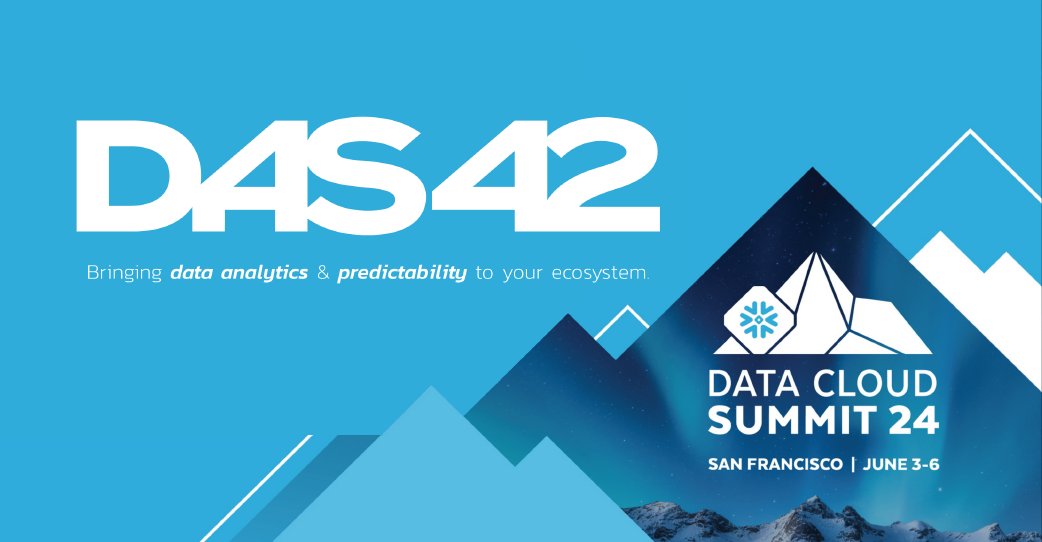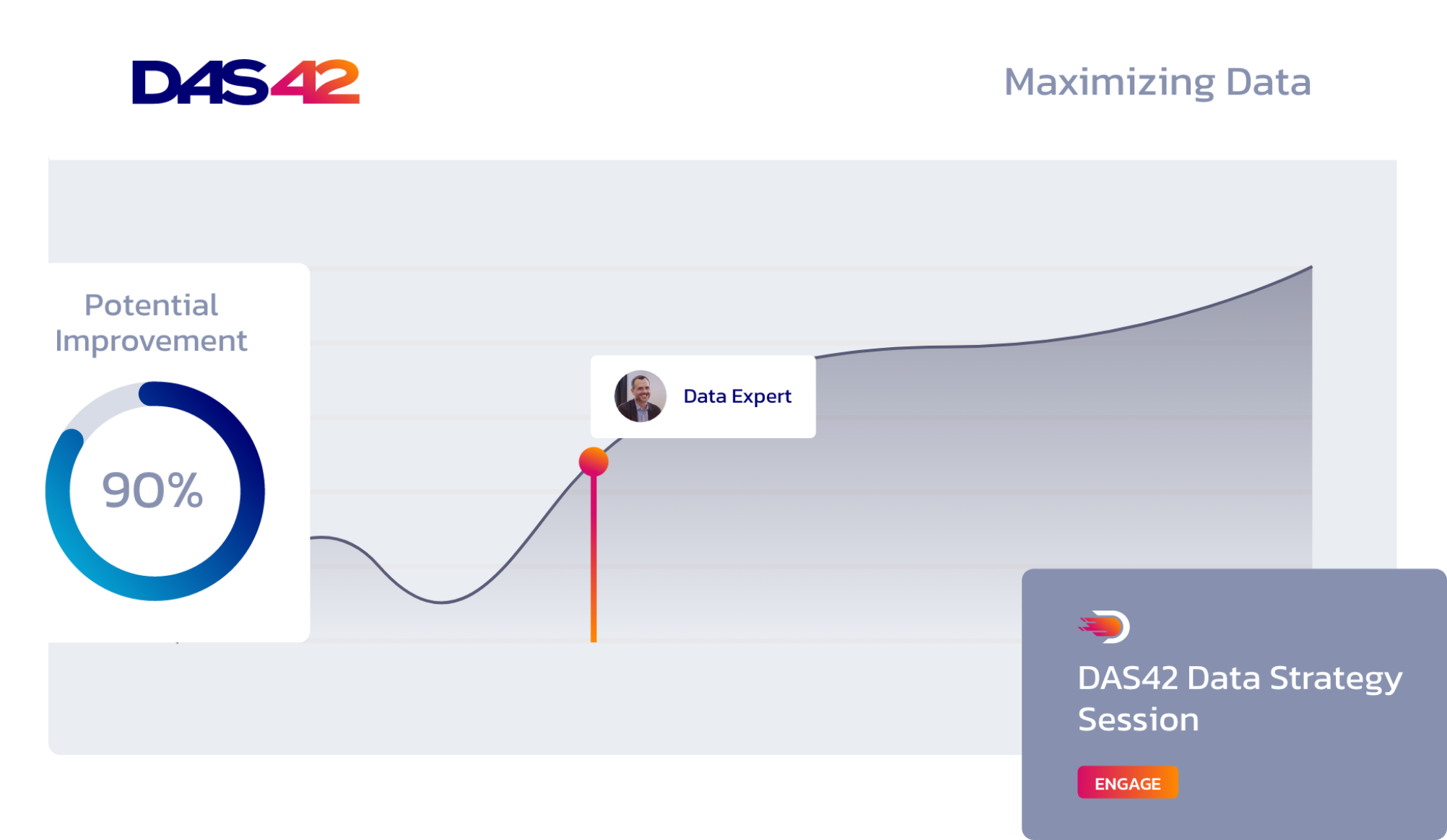Nearly all data engineers, at least once in their careers, have experienced a time when a business colleague sends a specific request to add logic for a business report or analysis. The data engineer builds the logic, gives it to the business user, and the business user then realizes that the logic doesn’t answer the question she was trying to solve in the first place.
This scenario epitomizes what is quickly becoming an adage in modern businesses: a business user makes a request with the organization’s data that she isn’t fully familiar with and the data engineer builds the logic without fully understanding the context of the business.
That’s where DAS42 comes in. DAS42 specializes in bridging the gap between business and technology. We speak the language of business but we’re also data experts. Guided by our FullStack Philosophy, we use modern cloud-based approaches and leverage the best data collection tools and platforms to help everyone in our client organizations to make better decisions faster.
One of the tools that we often implement for our clients to reduce their time to insights is the semantic layer.
Semantic layer 101: What is a semantic layer?
The semantic layer is an abstraction of data that simplifies and unifies data across an organization. The semantic layer is part of a modern tech stack and is the independent business layer where employees across your organization can access your organization’s data. Non-technical users don’t need to know all the inner, complex workings of your tech stack as the data is presented through the user’s perspective and derives a single source of truth.
The semantic layer opens the gate to your organization’s data access, cultivates data literacy, and provides the single source of truth that all data mature organizations need to thrive.
Four Benefits of the semantic layer
The purpose of the semantic layer is to achieve a trusted, agile pipeline that can serve all aspects of the business from the ad hoc self-service reporting all the way to data science. We’ve identified four key benefits for implementing a semantic layer in your tech stack.
1. Usability & understandability
The semantic layer allows users to understand queries and definitions without needing to understand the underlying data model, which makes the data more accessible to more users who don’t have to rely on the data experts in your organization. The semantic layer is also easy to modify and adjust–business users can build additional logic themselves within the layer without requiring submitting requests or tickets to your data experts. The semantic layer’s usability and understandability makes it an agile tool that reduces the time it takes for users to visualize your data and establish actionable insights.
2. Security & governance
We see data security and data governance challenges often with our clients. It’s a key factor in any organization’s data pipeline. The semantic layer solves security challenges: you can control when and what your users can access by delegating data access down to the row level.
The semantic layer also centralizes your logic and definitions, which is referred to as data governance. For example, one organization I worked for had six definitions of revenue. It was difficult to determine which definition was accurate and required meeting with multiple teams across the organization to discern which definition should be used. The absence of data governance spurred confusion and distrust in the organization’s data. Implementing a semantic layer can centralize the logic for your business and eliminate confusion.
3. Capability & enablement
I like to think of the semantic layer’s capability and enablement feature as overseeing the data governance. Instead of your organization’s analysts spending time tracking down data discrepancies, such as which of the six revenue definitions they should use, they can focus on the reports and analyses that take your organization to the next level.
The semantic layer’s structure also allows your teams to continue using the tools they know and love. The semantic layer sits in between your data, machine learning, and business intelligence platforms, so there’s no seismic change required by those teams.
4. Accuracy & reliability
The semantic layer removes the prerequisite of knowing SQL or how to code, as well as having any data analytics or engineering knowledge to use your data. The semantic layer generates sophisticated SQL statements from simple requests to ensure the right results. It also eliminates different definitions of the same metric and allows for a single value of truth across the entire organization, cultivating trust in the data.
These four benefits – usability and understandability, security and governance, capability and enablement, and accuracy and reliability – highlight the impact of what semantic layer can add to your business.
The semantic layer in Practice: Allocating variable costs to unit level
A previous client’s finance unit and economic teams wanted to allocate variable costs to the unit level. They had high level, aggregated views of their costs, for instance, vendor freight, but wanted to know how much each unit truly cost to gain a holistic view of their business. They were facing a number of challenges to determine the per unit cost:
It was iterative and time-consuming. The cost allocations process was complex and required collaboration across business units; accounting, finance, procurement, and individual business users would have to come together and provide the insights to make the allocations as accurate as possible. As the organization would try to build the allocations, new situations would arise that would require going back to the owner of the data pipeline, the data engineers, to change the process. As the rest of the company was reliant on the data engineers who often work in sprint cycles, the process was lengthy, taking two to three weeks per request for the allocations to be changed.
The other challenge was the lack of data governance and a central source of truth. The business departments would develop the logic in worksheets where it is easy to make one keystroke mistake that can have impact for all of your data, and make it difficult to pinpoint where that mistake originated later on in the process. Developing logic in worksheets is also very siloed as it can’t as easily be shared out with other business units in the organization.
The solution
The client’s challenges were resolved once DAS42 implemented a semantic layer. Referring back to its four key benefits, the semantic layer’s usability resolved the iterative and lengthy process the client was relying on before. The semantic layer’s security and governance features allowed the client to enforce security policies until the methodology was developed and approved to avoid users using the new methodology before it was stabilized. Once the methodology was shared across the organization, users had the capability and enablement as the layer can be used across a variety of existing business intelligence tools. The semantic layer made the data reliable as the logic is no longer siloed or varied across departments; a single source of truth was established and accessible across the entire organization.
Users now trust that the data is accurate and reliable and know the cost per unit with confidence.
Experience the benefits of implementing a semantic layer with the full-stack approach
From data literacy, tool adoption, data governance, to data applications, and advanced analytics DAS42 helps you get the most business value out of your data. We’re trusted by global enterprises and take ownership of your business challenges and opportunities, designing data and technology solutions based on your business goals and needs.
If your organization needs assistance transforming your data ecosystem from archaic and cumbersome into a modern, flexible, self-service process, contact DAS42.
Services provided









